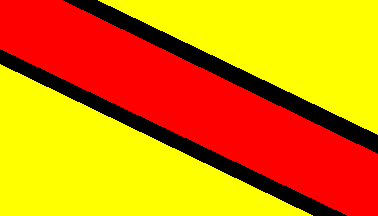 klaus-michael schneider
klaus-michael schneider
Keywords: el oro | portovelo |
Links: FOTW homepage | search | disclaimer and copyright | write us | mirrors

Last modified: 2021-08-26 by  klaus-michael schneider
klaus-michael schneider
Keywords: el oro | portovelo |
Links: FOTW homepage |
search |
disclaimer and copyright |
write us |
mirrors
 (4:7)
(4:7)
image by Ivan Sache, 17 April 2004
See also:
Flag and Coat of Arms of Portovelo in El
Oro Province at <www.portovelo.com>.
Dov Gutterman, 16 April 2004
The flag is yellow with a red (descending) diagonal stripe
separated from the yellow field by a thick black line. Proportion
of the flag seems to be 4:7.
Ivan Sache, 17 April 2004
On 23 March 2006, the "Diario Carreo"
announced the death of Juan Aurelio Zúñiga Galarza, who passed
away in Guayaquil, aged 86. He was a famous chronicler of
Portovelo, where everybody called him "Don Juan",
especially in the borough of La Deportiva where he spent all his
life. Don Juan was awarded in 2003 the title of Best Citizen of
the Canton of Portovelo. Juan Aurelio Zúñiga Galarza is the
designer of the flag and coat of arms of the Canton of Portovelo.
The city of Portovelo (15,000 inhabitants) is the capital of one
of the 215 Cantons of Ecuador (20,000 inh.; 286.2 sq. km),
located in the south-west of Ecuador, 570 kilometers from Quito
and 240 km from Guayaquil.
Portovelo is famous for its gold mines, including one of the
biggest in South America and perhaps in the world. The mine can
be visited with the carts used to transport raw ore. The
inhabitants of Portovelo claim that their village was the Inca
Eldorado dreamed by the European explorers; the Quechua name of
Portovelo is Curipamba, lit. the Land of Gold, and the city was
probably one of the most important in the Inca empire. Curipamba
was inhabited by the Paltas, members of the Cañari
Confederation, who fled to the mountains when the Spanish
conquistadores came. Those, led by Alonso de Mercadillo, founded
there the settlement of Asiento de Minas; after 40 years of
struggle against diseases and floodings by river Amarillo, they
moved 600 m uphill and founded the city of San Antonio de Zaruma.
The legend says that the local chief (cacique) Quinara took from
Portovelo a huge shipment of gold in order to pay the ransom of
Emperor Atahualpa; when he was told that Atahualpa had been
murdered by the conquistadores, he buried the gold in a cave
somewhere between Portovelo and Cajamarca.
In 1896, the South American Development Company (SADCO), from the
USA, exploited the mines of Portovelo, rebuilt the village and
became one of the richest in the world. The Mining Chamber of
Ecuador believes that 120 tons of gold have been extracted in
Porotvelo since the beginning of the XXth century. The company de
facto ruled most of the province of El Oro and a part of the
neighbouring province of Loja; it paid the workers with its own
currency to prevent them from deserting. The company was expelled
from Ecuador in 1946.
On 13 May 1968, Portovelo ceased to be a miners' camp and became
a parish. On 5 August 1980, the Canton of Portovelo was formed,
including the parishes of Portovelo, Curtincápac and Salatí.
The Canton then had only 4,500 inhabitants.
Source: <www.portovelo.com>.
Ivan Sache, 17 April 2006
Almost same image (with
much thicker black diagonals) is at <www.mipasaje.com>.
The description doesn't mention the black diagonals but those are
clear at <www.portovelo.com>.
Dov Gutterman, 14 September 2007
The canton of Portovelo was formed on 5 August 1980.
Translated from <www.mipasaje.com>:
"Author: Juan Aurelio Zúñiga Galarza
On a golden field a red diagonal stripe, meaning the strength of
the miners replicated in blood to retrieve the gold resources of
the soil rich in precious ore, represented by the yellow
colour."
Ivan Sache, 4 October 2008
o-pv.jpg)
image from <www.portovelo.com>,
located by Dov Gutterman, 16 April 2004